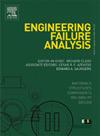Failure analysis of hook type grasping friction pair for automatic friction welding type strapping
IF 5.7
2区 工程技术
Q1 ENGINEERING, MECHANICAL
引用次数: 0
Abstract
Automatic friction welding type strapping machine is widely used for packing in industry, which can form solder welding joints of metal or polymer bundling strips by reciprocating high-frequency vibration friction. The hook type grasping friction pair (HTG friction pair) is one of the important vulnerable components, and its service life ranges from 16 million to 24 million vibrations at a vibration frequency of 400 times per second. The HTG friction pair of cold working die steel (SKD11) only lasted for 8 million vibrations before failing due to fracture, falls short of the required service life of 16 million to 24 million vibrations. Composition analysis, microstructure and fracture morphology characterization, and performance evaluation were conducted on the failed samples. The research results indicate that the HTG friction pair experienced multi-source high-cycle fatigue fracture at the chamfer radius and the hook groove, which is mainly because the chamfer radius is too small, and the hook grooves left on the surface by wire electrical discharge machining (WEDM) form stress concentration sources. Secondly, the forging ratio is insufficient, and the presence of eutectic carbide further accelerates the propagation of cracks. The optimization measures to improve the service life of HTG friction pair have been proposed.
自动摩擦焊式皮带钩式抓取摩擦副失效分析
自动摩擦焊式捆扎机广泛应用于工业包装,通过往复高频振动摩擦形成金属或聚合物捆扎条的焊点焊接。钩式抓握摩擦副(HTG摩擦副)是重要的易损件之一,其使用寿命为每秒400次振动频率下的1600万~ 2400万次振动。HTG冷加工模锻钢摩擦副(SKD11)仅持续了800万次振动就因断裂而失效,低于要求的1600万至2400万次振动的使用寿命。对失效试样进行了成分分析、显微组织和断口形貌表征以及性能评价。研究结果表明:HTG摩擦副在倒角半径和钩槽处发生了多源高周疲劳断裂,主要原因是倒角半径过小,电火花加工(WEDM)在表面留下的钩槽形成应力集中源;其次,锻造比不足,共晶碳化物的存在进一步加速了裂纹的扩展。提出了提高HTG摩擦副使用寿命的优化措施。
本文章由计算机程序翻译,如有差异,请以英文原文为准。
求助全文
约1分钟内获得全文
求助全文
来源期刊

Engineering Failure Analysis
工程技术-材料科学:表征与测试
CiteScore
7.70
自引率
20.00%
发文量
956
审稿时长
47 days
期刊介绍:
Engineering Failure Analysis publishes research papers describing the analysis of engineering failures and related studies.
Papers relating to the structure, properties and behaviour of engineering materials are encouraged, particularly those which also involve the detailed application of materials parameters to problems in engineering structures, components and design. In addition to the area of materials engineering, the interacting fields of mechanical, manufacturing, aeronautical, civil, chemical, corrosion and design engineering are considered relevant. Activity should be directed at analysing engineering failures and carrying out research to help reduce the incidences of failures and to extend the operating horizons of engineering materials.
Emphasis is placed on the mechanical properties of materials and their behaviour when influenced by structure, process and environment. Metallic, polymeric, ceramic and natural materials are all included and the application of these materials to real engineering situations should be emphasised. The use of a case-study based approach is also encouraged.
Engineering Failure Analysis provides essential reference material and critical feedback into the design process thereby contributing to the prevention of engineering failures in the future. All submissions will be subject to peer review from leading experts in the field.
 求助内容:
求助内容: 应助结果提醒方式:
应助结果提醒方式:


